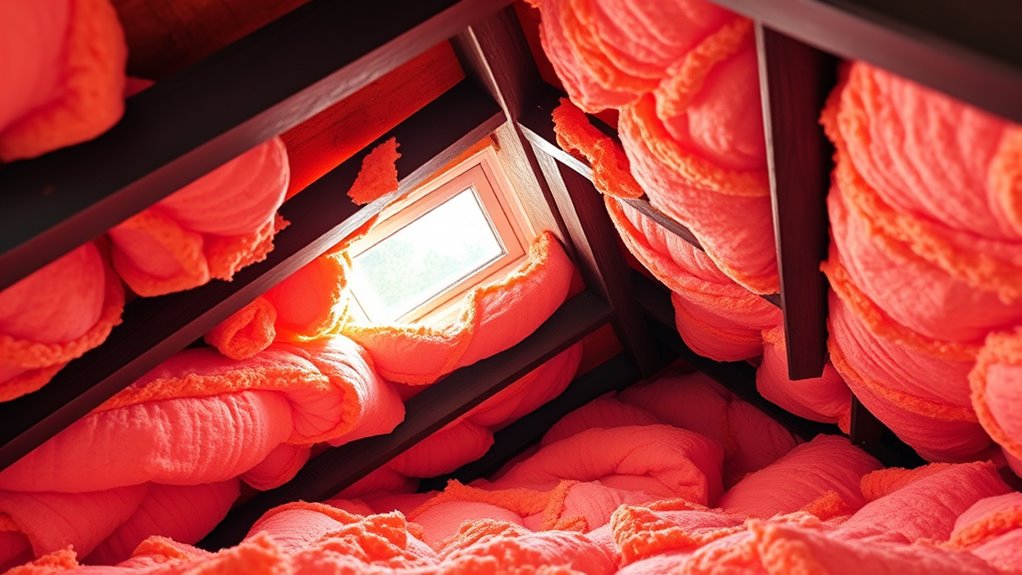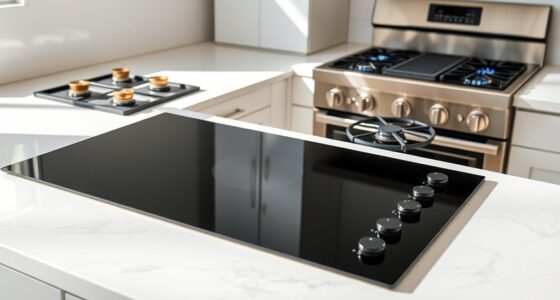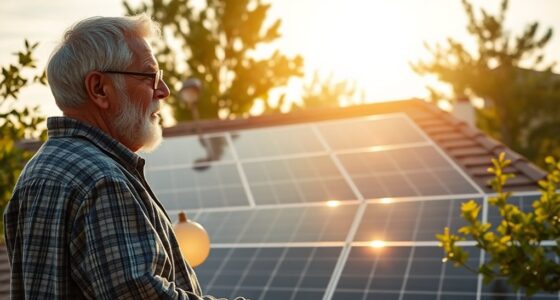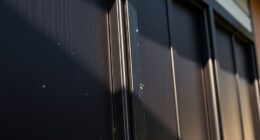To optimize your home’s insulation for energy savings, focus on selecting high R-value materials like spray foam, mineral wool, or cellulose, and guarantee proper installation without gaps or compression. Seal around windows, doors, and walls to prevent air leaks. In colder climates, prioritize insulation with high R-values, and in warmer areas, consider radiant barriers. Properly installed insulation reduces your HVAC workload, lowers energy bills, and boosts comfort. Keep exploring to discover more ways to enhance your home’s efficiency.
Key Takeaways
- Select insulation materials with high R-values like spray foam or mineral wool for better thermal resistance.
- Properly install insulation without gaps or compression to maximize heat retention and air sealing.
- Focus on insulating critical areas such as walls, attics, and floors to prevent heat loss and gain.
- Use reflective barriers in warmer climates to reduce heat gain and improve energy efficiency.
- Regularly evaluate and upgrade existing insulation to maintain optimal thermal performance and energy savings.
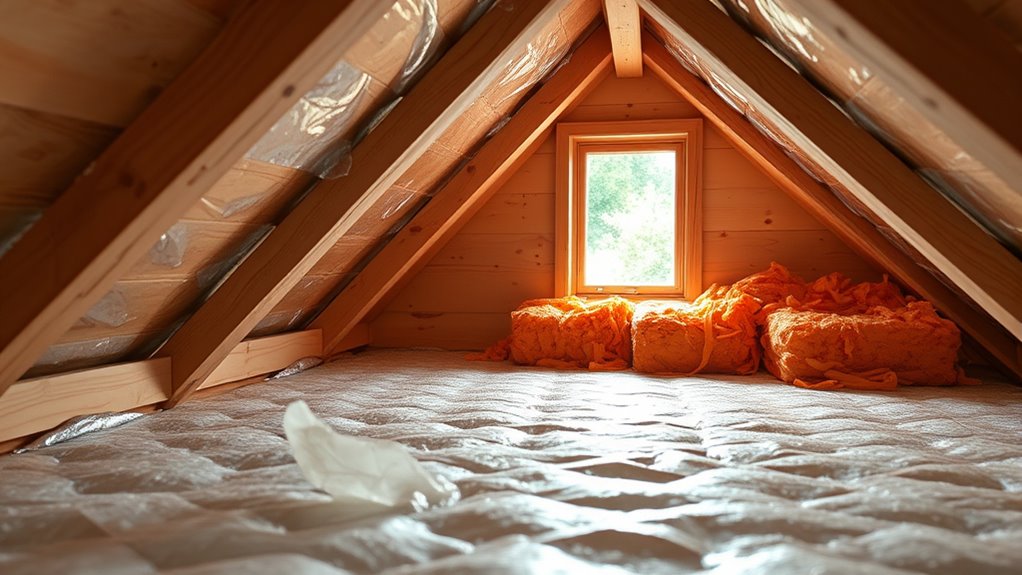
Are you looking for a simple way to cut your energy bills? Improving your home’s insulation is one of the most effective strategies you can adopt. When it comes to insulation, the key lies in enhancing thermal performance, which directly influences how well your house retains heat in winter and stays cool in summer. Better thermal performance means less strain on your heating and cooling systems, leading to lower energy consumption and savings on utility bills. To achieve this, choosing the right insulation materials is vital, as not all materials perform equally.
Your goal should be to select insulation materials that offer high thermal resistance, often measured as R-value. Materials like fiberglass, mineral wool, spray foam, and cellulose each have unique advantages in boosting thermal performance. Fiberglass, for example, is widely used because of its affordability and decent insulation properties. Mineral wool provides excellent fire resistance and soundproofing, while spray foam creates an airtight seal that prevents air leaks. Cellulose, made from recycled paper, is eco-friendly and provides good thermal resistance. Incorporating these materials into your walls, attic, and floors can markedly improve your home’s insulation quality, ensuring consistent indoor temperatures. Additionally, projected energy savings can be significant when insulation is properly installed.
Before installing or upgrading insulation, it’s vital to evaluate your existing setup. Identify areas where heat might escape or enter, such as gaps around windows, doors, or poorly insulated walls. Proper installation is just as important as choosing the right materials. Gaps or compression can undermine insulation’s thermal performance, allowing heat transfer to occur faster than it should. Make sure that insulation is evenly distributed and fitted tightly without gaps. If you’re unsure about installation, consulting a professional can ensure you maximize the effectiveness of the insulation materials.
Another essential factor is to consider the climate in your area. In colder regions, focus on insulation that offers high R-values to retain heat efficiently. In warmer climates, reflective or radiant barriers can help keep the home cooler by reducing heat gain. Improving thermal performance through optimized insulation also reduces the workload on your HVAC system, which can extend its lifespan and decrease maintenance costs.
Frequently Asked Questions
What Are the Latest Advancements in Insulation Materials?
You’ll find that the latest advancements in insulation materials include aerogel, which offers exceptional thermal resistance and lightweight installation, making insulation installation easier and more effective. Spray foam continues to improve, providing higher thermal resistance and better air sealing. Reflective foil insulations are also evolving, helping reflect heat and enhance overall energy efficiency. These innovations help you achieve ideal insulation performance, reducing energy costs and increasing comfort in your space.
How Do Climate Zones Affect Insulation Choices?
Climate zones are like different climates on a map, guiding your insulation choices. You should select climate-specific insulation to match your area’s temperature swings, whether it’s hot or cold. Regional building codes also influence what materials are permitted, ensuring safety and efficiency. By tailoring insulation to your climate zone, you create a cozy home that saves energy and complies with local standards, making your space both comfortable and compliant.
Can Insulation Improve Indoor Air Quality?
Yes, insulation can improve indoor air quality by reducing drafts and maintaining consistent temperatures. It also helps with indoor air filtration by limiting the entry of pollutants and allergens. Additionally, proper insulation prevents mold growth by controlling moisture levels, which improves overall air quality. By choosing the right insulation and ensuring proper installation, you create a healthier indoor environment, making your home safer and more comfortable.
What Is the Environmental Impact of Different Insulation Types?
Think of insulation choices as picking seeds for a garden; some grow quickly but exhaust soil, others last longer. You’ll find that fiberglass has high embodied energy and limited recyclability, making it less eco-friendly. Cellulose, with lower embodied energy and high recyclability potential, is a smarter choice. By selecting sustainable insulation, you reduce environmental impact, helping your home nurture a healthier planet while keeping energy bills in check.
How Often Should Insulation Be Inspected or Replaced?
You should inspect your insulation at least once a year, especially before the colder months. Follow the inspection schedule and replacement guidelines to identify signs of damage, moisture, or compaction. Generally, insulation needs replacement every 10-15 years, but this varies depending on the type and condition. Regular inspections help catch issues early, ensuring your insulation maintains energy efficiency and prevents costly repairs.
Conclusion
By optimizing your insulation, you can reduce energy costs considerably—up to 20% according to industry estimates. Not only does this lower your utility bills, but it also decreases your carbon footprint. Remember, properly installed insulation can improve your home’s comfort year-round. So, take action now; upgrading your insulation isn’t just smart—it’s essential for sustainable living and long-term savings. Make these changes today and enjoy the benefits of a more energy-efficient home.
